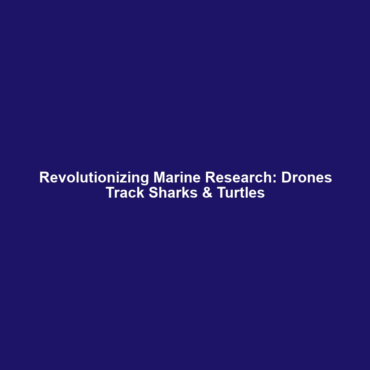Case Studies: Drones Tracking Shark Populations and Monitoring the Behavior of Sea Turtles
Introduction
The utilization of drones in science has revolutionized the way researchers study wildlife, particularly in marine environments. Case studies involving drones tracking shark populations and monitoring the behavior of sea turtles have provided critical insights into these marine species’ habits and habitats. This article explores the significance of these case studies within the broader context of drones in scientific research, highlighting their role in wildlife conservation and ecosystem management.
Key Concepts
Drones, also known as unmanned aerial vehicles (UAVs), offer a range of functionalities that are particularly valuable in marine biology. Here are some key concepts related to drones, shark populations, and sea turtle monitoring:
Drone Technology in Marine Biology
- Aerial Surveillance: Drones provide a bird’s-eye view of marine ecosystems, enabling researchers to monitor wildlife with minimal disruption.
- Data Collection: Advanced sensors and cameras equipped on drones facilitate real-time data collection of sea creatures, including sharks and turtles.
- Behavioral Analysis: Observing animal behavior from above helps scientists understand migration patterns and breeding habits.
Applications and Real-World Uses
The application of drones in tracking shark populations and monitoring sea turtle behaviors has gained traction in recent years. Here are some significant examples of how these technologies are used:
- Tracking Migration Patterns: Drones are employed to follow the migratory routes of sharks, providing data critical for conservation efforts.
- Nesting Monitoring: In the case of sea turtles, drones assist in identifying nesting sites and tracking hatching success rates.
- Population Studies: Researchers utilize drones to estimate population sizes by counting individuals in various habitats.
Current Challenges
While the application of drones in marine studies is promising, there are challenges and limitations that researchers face:
- Technical Limitations: Battery life and flight duration can limit the operational range of drones.
- Data Interpretation: Analyzing and interpreting the vast amount of data collected can be complex.
- Regulatory Issues: The use of drones is subject to local regulations that may restrict their operation in certain areas.
Future Research and Innovations
The future of drones in science, specifically in monitoring aquatic life, looks promising. Upcoming innovations include:
- Enhanced Battery Technologies: Next-generation batteries may increase flight times and operational ranges.
- Artificial Intelligence Integration: AI can automate data analysis and improve the accuracy of species counts.
- Real-time Communication: Improved communication technologies will allow for more effective coordinated research efforts across regions.
Conclusion
Case studies involving drones in tracking shark populations and monitoring the behavior of sea turtles play a crucial role in advancing our understanding of marine ecosystems. As technology continues to evolve, the impact of drones in scientific research is set to expand, providing invaluable contributions to wildlife conservation and management. For those interested in learning more about the applications of drones in various scientific fields, consider exploring additional resources on drones in conservation or marine biology studies.

Leave a Reply